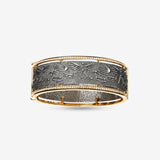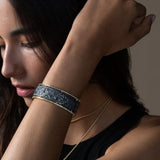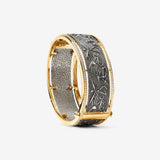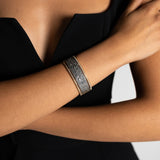SIGNATURE BRACELET
MANUAL EDITION
ANCIENT · MIDDLE EAST
We attend all our customers personally. Please leave us your contact details for information and sales.
We attend all our customers personally. Please leave us your contact details for information and sales.
We have a number of standard sizes in stock, others are tailor made. Please indicate your size. We will contact you to assure the perfect fitting.
DESCRIPTION
PRINT OF AN ORIGINAL MESOPOTAMIAN CYLINDER SEAL (1300 BC) · We use this 3000 old seal to cast its ageless identity in blackened silver, set in yellow gold, finished with a white diamond pave.
A bird, a hand, a scorpion, a star: an ancient signature print shaped into a contemporary object of identity.
-
Available in wrist sizes
-
3D print cast in blackened silver
-
18k gold frame
-
VVS G grade diamonds, total weight 2.06 carats
-
Width 2.2cm/0.87"

MESOPOTAMIAN CYLINDER SEAL (1300 BC)
Around 3500 BC, the evolution of the functional Mesopotamian stamp seal into the elaborate cylinder seal has been closely linked to the invention of cuneiform writing. For the next 3000 years, these miniature works of art took the expression of individual and social identity to an entirely new level.
Seals played a number of different roles in their ancient Near Eastern setting. They were by nature legal instruments of identity; they fulfilled ritual functions as amulets, they were public displays of social status, but above all they were - and they still are - objets d'art.
Within their archaeological context, cylinder seals must be considered as a major form of art. The combined aesthetics of beautifully crafted stones and the astonishing detail of their pictorial impressions, have produced a wide variety of unique gems. What the cylinder seals lacks in size, it gains in unexpected detail, in intensity, and first and foremost in historical relevance.
As civilizations came and went, their visual expressions, perpetuated in these small stones, offer us a wide array of icons and styles: combat scenes between heroes and animals, or worship scenes to enthroned gods or kings. This specific seal, from the Mitanni empire, is a fine example of more abstract and symbolic patterns: a scorpion, a bird, a hand, a star…
Because of their vital importance in the understanding of the birth of modern societies, Mesopotamian cylinder seals have been extensively studied by scholars and museums. Here under you find some similar references in shape, material and glyph design.



-
B. Buchanan, Early near eastern seals in the Yale Babylonian collection
-
L. Gorelick and A. J. Gwinnett, The ancient near eastern cylinder seal as social emblem and status symbol
-
A. Tsuneki, A glimpse of human life from the neolithic cemetery at Tell el-Kerkh, northwest Syria
-
B. Teissier, Ancient near eastern cylinder seals from the Marcopoli collection
-
S. Babcock, Rolling stones: looking at ancient Mesopotamian cylinder seals
Acquired at an antiquities dealer in London, legally exported under the British and European legislation for export of cultural goods. Authenticity has been certified by the professor W.G. Lambert.
SIGNATURE
More than 5000 years ago, every time a cylinder seal was rolled into wet clay, it pictured a story of beliefs, gods and heroes. More than 5000 years ago, stories of beliefs, gods and heroes were signatures of personal and social identity.
Stamp seals were the main markers of identity, when during the second half of the 4th millennium they gave birth to cylinder seals, and in parallel to the first cuneiform writing. During more than 3000 years these became the standard technology for signing documents, until they grew out of use when around 500 BC papyrus replaced clay as the predominant writing material.

As small works of art, cylinder seals played a big role in human society. States and empires were built upon the complex relations of humanity with gods, kings and myths. In the visual Mesopotamian cultures, imagery identified the wearer with specific social structures. Just like a Christian cross or a pop idol T-shirt indicate our belonging to ancient religions or modern cults.
As civilizations came and went, their visual expressions, perpetuated in these small stones, offer us a wide array of icons and styles. Combat scenes between heroes and animals, or worship scenes to enthroned gods or kings, tell us a great deal about the wearer, and about the society he was part of. More than makers of mark, cylinder seals were objects of art, status and expression.
Today, combat heroes have been replaced by sports idols, throne worships have been replaced by Instagram likes. We now sign documents with our face while we publish our lives on social networks. Modern identity has become a complex and fragmented business.
Cylinder seals are human signatures in all its aspects: cylinder seals are the blockchain, cylinder seals are Instagram. Beyond the identity of a person long gone, cylinder seals are a visual window to an ancient civilization, a social signature of who we were, essentially shaping who we are today.
We are the art we wear.









